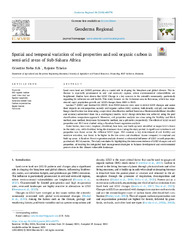| dc.description.abstract | Land cover land use (LCLU) patterns play a crucial role in shaping the biosphere and global climate. This influence is especially pronounced in arid and semi-arid regions, where environmental vulnerabilities are heightened. Studies have shown that LCLU Change is a key concern in the scientific community, particularly regarding its influence on soil health. This study focuses on the Gaborone area in Botswana, which has experienced rapid population growth and LCLU changes from 2002 to 2022.
Landsat 7 (2002) and Sentinel-2A (2022) from USGS datasets were used to detect LCLU changes and assess their impacts on soil properties, namely: soil organic carbon (SOC) content, bulk density, soil pH, and texture. Image classification was done using a supervised classification method based on a Maximum Likelihood classifier and accuracy assessment done via a contingency matrix. LCLU change detection was achieved using the post classification comparison approach. Moreover, soil properties analysis was done using the Walkley and Black method, core method, Bouyoucos hydrometric method, and a pH meter, respectively. The effects of LCLU on soil properties and SOC were studied using a Random Forest regression analysis.
Water bodies, tree cover, cropland, shrubland, bare land, and build-up were identified as major LCLU classes in the study area, with shrubland being the dominant class during the study period. A significant variation in soil properties was found across the different LCLU types. SOC content, a key determinant of soil fertility and moisture retention, was found to be higher in the tree cover and shrubland classes compared to cropland and built-up areas. A Random Forest regression analysis showed a substantial influence of LCLU on soil properties, particularly SOC dynamics. The study concludes by highlighting the interconnectedness of LCLU changes and soil properties, advocating for integrated land management strategies to balance devel | en_US |

